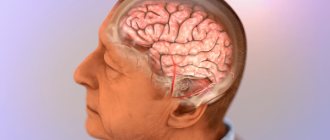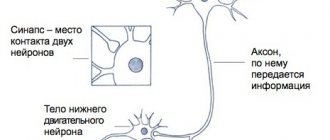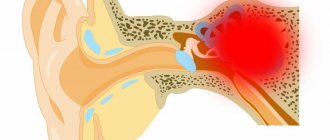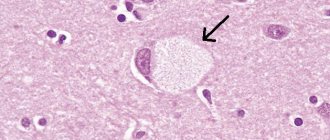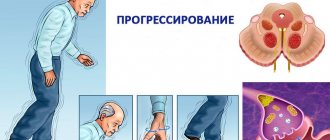Symptoms
Clinical manifestations of the disease depend on the conditional form:
- Classic Friedreich's disease (typical form);
- An atypical form of Friedreich's disease (with a slight breakdown in chromosome 9).
For the first time, classical Friedreich's disease (typical form) can make itself felt at a fairly young age, usually up to 25 years, less often the disease has a slower rate of development, then the first signs appear in the fourth decade of life (atypical form).
The disease often manifests itself with damage to the lower extremities, gait disturbances and motor coordination disorders (based on ataxia, which is of a mixed nature, cerebellar-sensitive). The patient notes uncertainty when walking, unsteadiness of gait, even falling. Over time, disturbances in the movements of the upper limbs and trembling in them may occur.
Over time, other neurological changes occur:
- Weakness in the leg muscles, up to paresis and paralysis (at the same time, the knee and Achilles reflexes decrease and later fade away, but pyramidal signs may be detected);
- Violation of deep and superficial sensitivity;
- Development of hearing loss, optic nerve atrophy;
- Speech impairment (if the disease lasts more than 5 years);
- Decreased cognitive function.
Somatic (extraneural) manifestations in the clinical picture of Friedreich's ataxia are the following symptoms:
- Shortness of breath, rapid heartbeat, paroxysmal cardialgia (these symptoms are caused by the development of cardiomyopathy);
- Skeletal anomalies in the form of kyphoscoliosis, cavus foot (“Friedreich’s foot”);
- Ovarian dysfunction, hypogonadism, diabetes mellitus.
Taking into account the damage to various structures of the nervous system, as well as the involvement of other body systems in the process, for diagnosis it is customary to distinguish between mandatory signs, common signs, and rare signs.
Obligate (obligatory) symptoms of the disease include:
- The onset of the disease is before the age of 25 years.
- Progressive cerebellar-sensitive ataxia.
- Progressive loss of coordination in the limbs.
- Fading knee and Achilles reflexes.
- Decreased deep sensation in the legs.
- Dysarthria – jerky, slow speech.
Common, but not obligatory, signs of the disease include:
- Pathological Babinski reflex.
- Hollow foot.
- Kyphoscoliosis.
- Weakness, hypotrophy and atrophy of the muscles of the limbs.
Rare signs of Friedreich's ataxia:
- Optic nerve atrophy.
- Nystagmus.
- Sensorineural hearing loss.
- Postural tremor.
- Vertigo.
- Spasticity in the limbs.
- Moderate cognitive impairment.
The clinician should be alerted and directed to look for other diseases by the presence of the following signs: early manifestation of the disease (up to 2 years), severe cognitive impairment, the presence of extrapyramidal pathology syndromes, sensorimotor neuropathy, decreased speed of nerve impulse transmission along motor fibers, ophthalmoplegia.
It should be remembered that the atypical form of the disease is not characterized by: total areflexia, cardiomyopathies, endocrine disorders.
Diagnosis of Friedreich's ataxia
First of all, during the diagnosis of the disease, the clinical picture should be assessed and the obligatory manifestations should be identified. There are also a number of important instrumental research techniques:
- MRI of the brain. Allows you to find spinal cord atrophy (reduction in the diameter of the spinal cord, increasing in the caudal direction - at the expanded stage). MRI allows visualization of moderate atrophic changes in the pons, medulla oblongata and cerebellum.
- At the initial stages of the development of the disease, it is important to conduct neurophysiological studies:
— Electroneuromyography: disturbances in the conduction of nerve impulses predominate in sensory fibers rather than in motor fibers.
— Glucose tolerance test (exclude diabetes).
— X-ray examination of the spine and feet (detection of bone deformities).
— ECG – conduction disturbances, inversion of the electrical circuit, hypertrophy of the interventricular septum. It should be noted that cardiac disorders often precede neurological changes by several years.
- MSCT of the brain. It is ineffective in diagnosing the disease, since it allows visualizing cerebellar atrophy only in the later stages. Indirect signs of the disease are: atrophy of the hemispheres, expansion of the stem cisterns, lateral ventricles.
It is also important to conduct a number of blood tests: genetic research (DNA diagnostics - detection of mutations in the FXN gene using blood PCR) and determination of succinate dehydrogenase using a cytochemical method. It is important to note that prenatal diagnosis of chromosomal mutations is now possible.
Differential diagnosis of Friedreich's ataxia is carried out with the following diseases:
- Hereditary ataxia caused by vitamin E deficiency: similar in clinical picture, however, upon diagnosis, a number of laboratory changes are detected: reduced levels of vitamin E in the blood, acanthacytosis in the blood smear, lipid metabolism disorders.
- Other metabolic diseases with an autosomal recessive type of inheritance: gangliosidosis and galactosialidosis (detection of the activity of B-galactosidase and hesosaminidase A); Krabbe disease (study of galactosylceramidase activity); late variant of Niemann-Pick disease (determination of the content of sphingomyelins in the cerebrospinal fluid, examination of sternal puncture to detect “foam” cells).
- Multiple sclerosis: the clinical picture of this disease is dominated by pyramidal symptoms: often brisk tendon reflexes, pyramidal tone, loss of abdominal reflexes, foci of demyelination on MRI, alternating remissions and exacerbations. Not typical: areflexia, hypotension, somatic manifestations, amyotrophy.
Treatment
There is currently no pathogenetic treatment for the disease, so all measures are aimed at eliminating the symptoms of the disease.
Patients with Friedreich's ataxia are treated by doctors of several specialties: cardiologists (patients often turn to them for the first time, and often these patients are observed with a diagnosis of rheumatic heart disease for several years, until other symptoms of the disease manifest themselves), orthopedic traumatologists (surgical treatment of defects foot, kyphoscoliosis), endocrinologists (diagnosis and treatment of diabetes mellitus and hormonal dysfunction of the ovaries), less often ENT doctors and ophthalmologists encounter this disease in their practice.
However, more often, and logically, the patient is seen by a neurologist, who coordinates the patient’s actions (refers to specialized specialists for diagnosis and correction of extraneural disorders).
As for drug therapy, treatment is of a general strengthening nature:
- Drugs with an antioxidant effect (ethylmethylhydroxypyridine succinate), when the disease is combined with diabetes mellitus - thioctic acid (Berlition, Thioctacid, Octolipen); vitamins A, E, multivitamins).
- Agents that improve metabolism in the heart muscle and in the cells of the nervous system: meldonium, cocarboxylase, riboxin. They also use a drug that is structurally similar to coenzyme Q10 - idebenone.
- Drugs with nootropic effects (choline alfoscerate (Cerepro, Gliatilin, Noocholin), piracetam, aminobutyric acid).
An important method of treatment is exercise therapy and massage. These methods allow patients to maintain muscle strength and maintain motor activity for a longer period of time, and also help reduce the intensity of pain in the muscles of the limbs.
4.Treatment
Therapy for Friedreich's ataxia is palliative (symptomatic), restorative and supportive in nature. Thus, as it increases, and to the extent that modern therapeutic capabilities allow, symptoms of cardiac and/or respiratory failure are relieved, blood glucose levels are corrected, nootropics are prescribed (stimulants of nutrition and metabolism in neural tissues, allowing some thus slow down the degradation of neuropsychic functions). A significant role, taking into account the main etiopathogenetic mechanism, is assigned to antioxidant and vitamin complexes, but it has not yet been possible to completely normalize the intracellular iron balance. With an increase in pathological changes in the musculoskeletal system, vertebrosurgical correction may be required, with the development of cataracts, appropriate ophthalmological support, etc. Physiotherapeutic procedures, physical therapy, and massage are of great importance (in terms of preserving and maintaining an acceptable quality of life for as long as possible). . However, patients gradually become more and more helpless and, from a certain point, need care, total guardianship and solutions to social security issues.
Disease prognosis
Given the lack of pathogenetic treatment, it should be understood that the disease is steadily progressive. Patients with a diagnosed disease live on average 10-15 years and, as a rule, no more than 30 years from the onset of its development; in women, the course of the disease is more favorable - their life expectancy often exceeds 20 years. Death occurs as a result of the development of pulmonary or heart failure.
However, timely diagnosis and application of the above treatment methods, impact on concomitant pathology, and prevention of complications contribute to improving the quality of life and prolonging it in patients with Friedreich's ataxia.
General information about the disease
The disease is typical for both men and women. At the beginning of the disease, neurological disorders are observed - impaired walking and difficulty maintaining balance. These are specific signs inherent in this particular disease. Over time, ataxia progresses. The patient develops problems with speech clarity, cataracts form, hearing loss and dementia develop.
Friedreich's disease progresses over many years and is accompanied by gradual damage to the nervous system, as well as extraneural changes. The pathology affects the organs of vision, heart, and musculoskeletal system. For this reason, doctors of different specializations treat ataxia: neurologists, ophthalmologists, cardiologists, endocrinologists, orthopedists.
The average duration of the disease is about 20 years. In the absence of diabetes and heart pathologies, patients live up to 70-80 years. The cause of death is heart or pulmonary failure, complications after an infectious disease. In women, the first signs of the disease appear later than in men. As a rule, they live longer.
Treatment of ataxia is conservative. The patient is prescribed the necessary medications, a special diet is prescribed, and physical therapy exercises are selected without fail. Surgery is performed only in cases of significant bone deformation to improve the patient’s quality of life.

